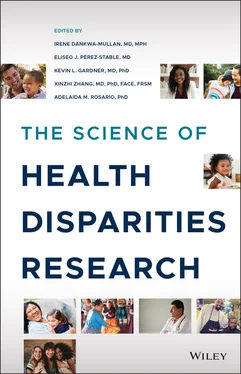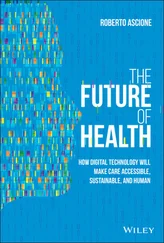1 ...8 9 10 12 13 14 ...36 One example where this was prospectively addressed is the Diabetes Prevention Trial that evaluated results by race/ethnicity [18]. The lack of diverse genotype data on minority populations in the United States has been highlighted [19], and the randomized trials evaluating efficacy of prostate cancer screening, for example, have had limited minority participation despite the fact that prostate cancer is two to three times more common among African Americans [20–22]. Future clinical research needs to ascertain greater granularity of social and demographic determinants in addition to age, gender, and race/ethnicity, such as SES, birthplace, language proficiency, sexual orientation/gender identity, and geographic residence.
Many investigators find it challenging to recruit minorities to participate in clinical studies. Successful recruitment may require different strategies, more resources, and, frequently, unfamiliar skills. Research indicates that recruitment of minorities may be more successful when active strategies (e.g., more in‐person contact, personalized messages, and active outreach) are used rather than passive strategies (e.g., mass mailings, advertisements), which are the norm for many studies [23]. Further research is needed to understand the best mechanisms to recruit and retain minority and other health disparity populations in clinical research, especially clinical trials to identify the most appropriate prevention, detection, and treatment strategies for everyone. Given that minorities constitute close to 40% of the US population, diversity of participants in clinical studies is not merely a legal mandate but critical to the conduct of ethical, equitable, and rigorous science.
Although significant challenges remain, increasing public interest and scientific advancements point to opportunities to better understand the causes of, and potentially eliminate, certain disparities. It is important for minority health and health disparities researchers to construct consistent/standardized terminology and extend cross‐collaborations and networks with diverse research communities using interdisciplinary approaches. The science of minority health and health disparities is a platform not only to reduce inequities but to advance knowledge in health and healthcare for all populations.
The scientists who have addressed minority health and health disparities come from a variety of disciplines. Historically, scientists conducting research on minority health and health disparities have come from epidemiology, sociology, psychology, economics, anthropology, demography, and other social sciences. Increasingly, clinician investigators, health services researchers, and translational scientists have become engaged in these topics, leveraging the power of computational techniques and advances in data collection methods. More recently, scientific advances have led to increased collaboration between social and clinical scientists and basic biomedical and data scientists. The importance of engaging communities, service providers, and policymakers is also increasingly recognized. Clearly, the broad spectrum of the field makes the task of scientific orientation daunting but necessary. The objective of this book is to create a starting point and reference for emerging and early career investigators, including graduate students, postdoctoral scholars, and junior faculty. This book is intended to lay the foundation and be a guide for scientific inquiry in minority health and health disparities research.
Constructing consistent/standardized terminology on minority health and health disparities research.
Encouraging collaborations and networks among diverse research communities.
Promoting an interdisciplinary approach with three major focus areas: clinical and health services research, integrative biological and behavioral sciences, and community health and population health sciences.
The views and opinions expressed in this chapter are those of the authors only and do not necessarily represent the views, official policy, or position of the U.S. Department of Health and Human Services or any of its affiliated institutions or agencies.
1 1 Heckler, M.M. (1985). Report of the Secretary's Task Force on Black and Minority Health. Washington, DC.: US Department of Health and Human Services.
2 2 Schulman, K.A., Berlin, J.A., Harless, W. et al. (1999). The effect of race and sex on physicians' recommendations for cardiac catheterization. New England Journal of Medicine 30: 618–626.
3 3 National Academy of Medicine (2003). Unequal Treatment: Confronting Racial and Ethnic Disparities in Health Care (eds. B.D. Smedley, A.Y. Stith and A.R. Nelson). Washington, DC: National Academies Press.
4 4 Haiman, C.A., Stram, D.O., Wilkens, L.R. et al. (2006). Ethnic and racial differences in the smoking‐related risk of lung cancer. New England Journal of Medicine 354: 333–342.
5 5 Kanaya, A.M., Adler, A., Moffet, H.H. et al. (2011). Heterogeneity of diabetes outcomes among Asians and Pacific Islanders in the US. The Diabetes Study of Northern California (DISTANCE). Diabetes Care 34: 930–937.
6 6 Karter, A.J., Ferrara, A., Liu, J.Y. et al. (2002). Ethnic disparities in diabetic complications in an insured population. Journal of the American Medical Association 287: 2519–2527.
7 7 Centers for Disease Control (2015). Vital signs: leading causes of death, prevalence of diseases and risk factors, and use of health services among Hispanics in the United States — 2009–2013. Morbidity and Mortality Weekly Report 64 (17): 469–478.
8 8 Rudd, R.A., Seth, P., David, F., and Scholl, L. (2016). Increases in drug and opioid‐involved overdose deaths––United States, 2010–2015. Morbidity and Mortality Weekly Report 65: 1–8.
9 9 Chetty, R., Stepner, M., Abraham, S. et al. (2016). The association between income and life expectancy in the United States, 2001–2014. Journal of the American Medical Association 315 (16): 1750–1766.
10 10 Cubbin, C., Pollack, C., Flaherty, B. et al. (2011). Assessing alternative measures of wealth in health research. American Journal of Public Health 101: 939–947.
11 11 Garcia, M.C., Faul, M., Massetti, G. et al. (2017). Reducing potentially excess deaths from the five leading causes of death in the rural United States. MMWR Surveillance Summaries 66 (2): 1–7.
12 12 Global Burden of Cardiovascular Diseases Collaboration (2018). The burden of cardiovascular disease among US States, 1990‐2016. JAMA Cardiology 3 (5): 375–389.
13 13 Bronfenbrenner, U. (1977). Toward an experimental ecology of human development. American Psychologist 32 (7): 513–531.
14 14 Hill, C.V., Perez‐Stable, E.J., Anderson, N.A., and Bernard, M.A. (2015). The National Institute on Aging Health Disparities Research Framework. Ethnicity & Disease 25 (3): 245–254.
15 15 Paradies, Y., Ben, J., Denson, N. et al. (2015). Racism as a determinant of health: a systematic review and meta‐analysis. PLoS One 10 (9): e0138511. https://doi.org/10.1371/journal.pone.0138511.
16 16 Bhardwaj, A., Sanjeev, K., Alsam Khan, M. et al. (2017). Racial disparities in prostate cancer: a molecular perspective. Frontiers in Bioscience, Landmark 22: 772–782.
17 17 Starfield, B. (1998). Primary Care: Balancing Health Needs, Services and Technology. New York: Oxford University Press.
18 18 Diabetes Prevention Program Research Group (2002). Reduction in the incidence of type 2 diabetes with lifestyle intervention or metformin. New England Journal of Medicine 346 (6): 393–403.
19 19 Popejoy, A.B. and Fullerton, S.M. (2016). Genomics is failing on diversity. Nature 538 (7624): 161–164.
Читать дальше












